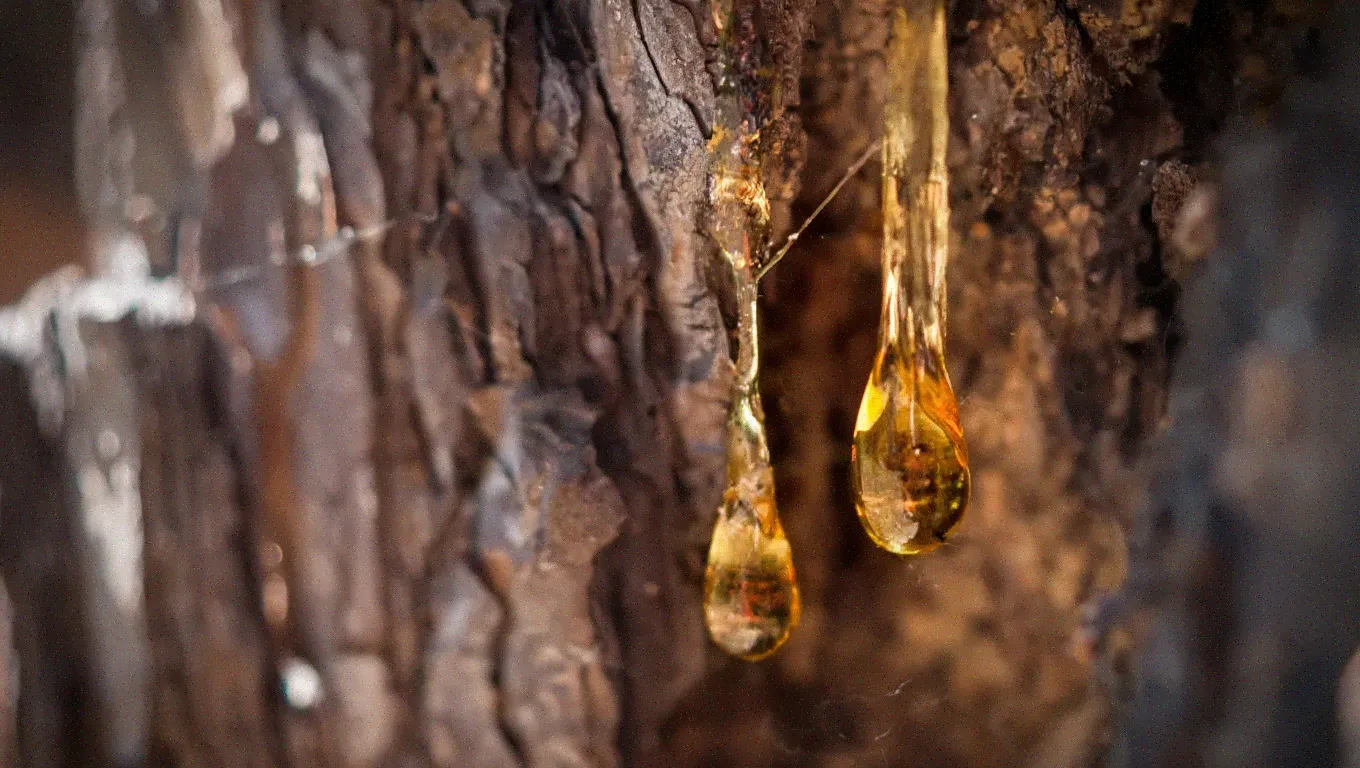
The Architectonics of Non-Sweet Resinous Wood: A Study in Structural Tenacity
I. The Resinous Divide: An Olfactive Taxonomy for the Perfumer’s Palette
A. Defining the Archetype: Beyond Balsam and Amber
The classification of resins in perfumery requires precise definition to separate the warm, confectionery-leaning compounds from those materials that function as dry, structural pillars. Historically, the term “balsamic” was functional, denoting materials prized for high tenacity and fixative power. In contemporary olfactive language, however, “balsamic” often generalizes to describe a rich, heavy, sweet, and incense-like note. The non-sweet woody resin profile mandated by this brief necessitates a deconstruction of this term, prioritizing structural density and tenacity divorced from sugary modifiers.
The required resinous archetype must function as an architectural pillar, delivering density through pyrogenic (smoky), spicy, and leathery characteristics, rather than relying on the amber-vanillic cushion provided by materials such as Benzoin or Peru Balsam. These woody notes are inherently renowned for adding depth, character, and a long-lasting presence to any composition. The pursuit of a non-sweet resin is fundamentally the pursuit of this fixed, grounded depth, but isolated from the oxygenated functional groups responsible for saccharine or creamy facets. This means substituting the fixative power of traditional balsams, which are often inherently sweet, with chemically distinct, non-vanillic molecules, primarily complex, fixed terpenoids.
B. The Chemical Vectors of Density: Terpenoids vs. Esters and Phenols
The profound difference between the sweet and non-sweet resin profiles is dictated by chemical structure. The Balsamic Axis—encompassing sweet resins like Benzoin and Labdanum—is often characterized by high concentrations of cinnamic acid derivatives, esters, and natural phenols such as vanillin. Siamese Benzoin, highly valued by perfumers, is notably defined by its deeply vanilla-toned facet, rendering it inherently sweet.
Conversely, the desired Terpenic Axis is defined by the predominance of cyclic organic compounds: mono-, sesqui-, and diterpenoids. Monoterpenes confer the sharp, clean, and volatile, sometimes camphoraceous lift—the true terpenic sensation found in conifers. Crucially, the non-sweet, fixed character is delivered by the heavy, dry anchor of sesquiterpenes and their rearrangement products. For instance, the pyrogenic, smoky elements characteristic of certain heavy woods are often linked to complex sesquiterpenoid oxides and epoxides (such as the epoxyguaiane families identified in Guaiacwood). These molecules possess the high molecular weight necessary for tenacity (functioning like a balsam) but lack the requisite functional groups that confer sweetness, allowing the resin profile to be purely structural, dry, and sharp.
C. Resin Olfactive Profile Comparison: Woody-Terpenic vs. Balsamic-Sweet
The following comparison clarifies the olfactive and chemical separation necessary for effective formulation when seeking heavy, dry, resinous materials.
| Olfactive Category | Key Materials | Primary Chemical Signature | Sweetness Level | Dominant Non-Sweet Facets | Perfumery Role |
|---|---|---|---|---|---|
| Woody-Terpenic Resins | Rosin/Colophony, Black Hemlock, Guaiacwood, Agarwood | Mono- and Sesquiterpenoids, Resin Acids | None to Trace | Dry, Spicy, Terpenic, Smoky, Leather, Sawdust, Varnish | Backbone, Dry Volume, Tenacious Fixation |
| Balsamic-Amber Resins | Labdanum, Benzoin, Opopanax, Peru Balsam | Phenylpropanoids, Esters, Vanillin, Cinnamates | Medium to High | Sweet, Vanilla, Honey, Caramel, Cinnamic, Fruit | Ambery Accords, Warmth, Sweet Fixation |
II. The Sweet Counterpoint: Balsamic Resins and Their Architectural Limitations
To isolate the identity of the dry woody resin, it is necessary to establish a definitive olfactive profile of the reference sweet materials, delineating the boundaries of the non-sweet brief.
A. Labdanum (Cistus): The Sweet Depth and its Contradictions
Cistus Labdanum is indispensable as an anchor in the oriental and amber families, providing immense warmth and depth. Its default olfactive profile includes warm, resinous, and amber notes, often complemented by soft and sweet facets that evoke vanilla and honey. This intrinsic sweetness makes the material a standard component of amber accords.
However, Labdanum is a complex material capable of exhibiting opposing forces. Analysis of different extracts demonstrates a spectrum, from notes that are fresh and fruity (like Davana) to those that are profoundly dry, smelling of “dry smoke and burnt paper, as though [one] stepped into an old chapel filled with heavy incense”. To utilize Labdanum in a non-sweet, purely structural woody context, the perfumer must utilize specialized fractional extracts, such as the ‘Light Absolue,’ which focus on the peppery edges and temple incense profile while successfully avoiding the caramelic, honeyed, or fruity dimensions that define traditional sweet amber notes. Even when combined with woody accords like cedar and patchouli, Labdanum’s innate richness often requires careful counterbalancing to prevent the composition from leaning too heavily into the amber genre.
For an in-depth exploration of sweet, balsamic resinous materials that provide the contrasting warmth to these dry, structural notes—particularly cistus absolute and labdanum—see: Cistus Absolute: The Amber Fixative in Woody and Leather Perfumery.
B. Benzoin and Opopanax: The Confectionery Resins
Benzoin, often marketed as Friar’s Balm or Storax, sets the gold standard for sweet fixation. Extracted from Styrax trees, it is defined by its rich, smooth, and notably vanilla-nuanced character. Its chemical reliance on cinnamates and benzoates places it squarely outside the chemical parameters of the non-sweet woody brief, making it a powerful exemplar of the sweet, balsamic end of the spectrum.
Opopanax, while offering richness and subtle spicy facets, is chemically similar to myrrh but is generally defined by its warm, honey-like balsamic character and comforting sweetness. The desire to reference Opopanax in the context of non-sweet woods indicates a pursuit of its density, spice, and heavy feel, but with the honeyed component surgically removed. The challenge lies in replicating its impressive tenacity without relying on the structural components that naturally lend sweetness.
C. Incense (Frankincense and Myrrh) as Dry Precursors
Frankincense (from Boswellia) and Myrrh (from Commiphora) are oleo-gum-resins that serve as important, naturally dry precursors to the woody-resin profile. Frankincense essence, obtained by steam distillation, is a powerful aromatic base note defined by a camphorated, resinous, and smoky effect, often possessing woody and lemony aspects. While highly volatile due to its monoterpene content, its inherent dryness makes it a valuable modifier for the heavier woody resins.
Myrrh is intensely aromatic, offering a rising balsamic, woody, and liquorice odor with almost fruity and incense facets. It can also be described as dark, slightly medicinal, or anisic. These medicinal and camphorous profiles, often generated by non-sweet alcohols and ketones prevalent in oleo-gum resins, provide a direct, non-sweet route toward density that is structurally adjacent to the terpenic woods. This suggests a strategic compositional approach where the medicinal, non-sweet sharpness of these materials can be combined with a dry wood note (such as Cedar) to reinforce the desired terpenic structure and circumvent the need for sweetness entirely. Both Incense and Myrrh, due to their low ester/cinnamate content, provide a key chemical link between classical ritual materials and modern structural dry woods.
III. The Terpenic Heart: Rosin, Colophony, and the Sawdust Facet
A. Rosin (Colophony): The Essence of Non-Volatile Terpenic Structure
Rosin, or Colophony, provides the quintessential olfactive benchmark for the dry, sharp, non-sweet, structural resin. Chemically, Rosin is the non-volatile residue remaining after the distillation of turpentine from pine sap, consisting primarily of dense diterpene resin acids. This structure is intensely terpenic (pine-like) yet non-volatile and fixed.
In perfumery, materials related to Rosin, such as Breu Branco (white rosin/colophony), embody this profile. The scent is complex, providing a balsamic warmth but simultaneously evoking the dry, structural nature of wood treatment materials, reminiscent of violin varnish, mahogany, cypress, and maple shavings. This dry, woody depth is the olfactive signature of high-molecular-weight terpenic acids. By establishing Rosin as the zero-sweetness fixative baseline, the perfumer recognizes that a resin can be intensely heavy and tenacious while remaining wholly dry, contrasting directly with the sugar-derived fixation of compounds like Benzoin. The note of “violin varnish” implies a refined, clean, almost chemical dryness that is structurally elegant and precise.
B. Black Hemlock and Pine: Terpenoid Concentration as Olfactive Intensity
The aggressive, sharp, and highly terpenic quality (pine, fir) is critical to conveying the sensation of raw, freshly processed wood, often described as “sawdust or wood shavings.” Conifers, such as Black Hemlock (Eastern Hemlock) and various Pinus species, rely on high concentrations of constitutive mono- and sesquiterpenes as a defense mechanism.
In composition, this high terpenoid concentration translates directly into the sharp, volatile pine facet. Pine and fir resins are highly favored, often in synthetic scents, for their ability to deliver authentic botanical character and structural complexity. Utilizing precision dosing of these high-terpenic isolates provides the necessary sharp, unsweetened volatility on the top and mid-notes, creating a “crisp, invigorating” sensation that perfectly complements the heavier, fixed base resins. This duality—sharp volatile terpenes giving way to fixed, heavy terpenes—creates the multidimensionality of the woody resin profile.
IV. Case Studies in Heavy Woody Resins: Depth, Smoke, and Structure
The practical application of non-sweet resin chemistry is best understood through an analysis of key materials identified as having high structural density.
A. Agarwood (Oud) and White Oud: The Ultimate Resin Anchor
Agarwood, or Oud, is recognized for its rare, deep, and intensely resinous aroma, functioning as an iconic component of intense woody perfumes. It provides necessary depth, smokiness, and long-lasting tenacity.
The specific reference to “white oud” in this context points to a fractional approach. Traditional, darker Oud can possess highly complex animalic or fungal notes. “White Oud” often denotes an expensive, fractional material that is refined to minimize or eliminate these complex, often fecal or cheesy facets. This process effectively maximizes the structural resin and the dry, pyrogenic smoke associated with the material, delivering the heavy, fixed, non-sweet anchor required without the added complexity of heavy indolic molecules. Oud, in this fractional form, provides the most intense, deep expression of a non-sweet woody resin.
B. Guaiacwood (Bulnesia sarmientoi): Smoke, Leather, and the Epoxyguaiane Complex
Guaiacwood oil (Bulnesia sarmientoi) possesses a distinct scent profile described as smoky, woody, and resinous. While sometimes noted as slightly sweet or balsamic, its complexity is profoundly anchored by depth and smoke.
The chemical characterization of Guaiacwood extracts provides the molecular foundation for its desired profile. Extensive analysis confirms the presence of numerous sesquiterpenoids, including 15 novel compounds, notably belonging to the 5,11- and 10,11-epoxyguaiane families. These heavy, oxidized, and rearranged sesquiterpenoids are the molecular source of Guaiacwood’s characteristic smoky, heavy, and potentially leathery notes. This inherent chemical stability and high molecular weight ensure that Guaiacwood enhances the longevity of the fragrance. The perfumer must emphasize these fixed fractions, often found in the heavier base notes, to maximize the heavy, dry resinous effect and ensure the profile remains far from the lighter, slightly sweet balsamic spectrum. The leathery or smoky facet, therefore, is understood as a natural consequence of the dense, highly fixed, oxidized terpenoid structures, the very opposite of fresh, volatile terpenes.
C. Cedarwood Varieties: Dryness, Spicy Volume, and the Terpenic Edge
Cedarwood is a versatile and common note, but its resinous profile varies significantly by species:
- Atlas Cedarwood (Cedrus atlantica): This species offers a warm, woody, and slightly sweet scent. The absolute is described as sweet, balsamic, dry, and resinous, sometimes with an intriguing note of apricot liqueur. This minor sweetness is not confectionery but rather a dense, dry consequence of the high concentration of resins and lignans in the absolute.
- Siberian Cedarwood (Pinus sibirica): Critically, this variety has a more balsamic and resinous scent compared to other types. Given its Pinus botanical source, this indicates a higher concentration of resin acids and diterpenoids, aligning it more closely with the dry density of the Rosin archetype and providing necessary structural volume.
- Virginian (Juniperus virginiana) and Texas Cedarwoods (Juniperus ashei): These varieties provide sharper, more pungent, herbal, or spicy notes. They contribute the required spicy-resinous volume and support the sharpness needed to achieve the “sawdust” or “wood shavings” facet.
D. Detailed Analysis of Key Resinous Woody Materials
The following materials represent the core palette for achieving the desired dry, non-sweet, heavy resin character. The analysis demonstrates how the aging or refining process concentrates the fixed, non-sweet molecules.
| Material | Source (Botanical) | Resinous Descriptor | Key Non-Sweet Facets | Chemical Insight |
|---|---|---|---|---|
| Rosin/Colophony | Pinus spp. (Oleoresin residue) | Signature Terpenic Resin | Sharp, Sticky, Dry Wood, Sawdust/Shavings, Varnish | Diterpene Resin Acids (Abietic Acid, etc.) |
| Guaiacwood Oil | Bulnesia sarmientoi | Smoky, Heavy Resin | Pyrogenic (Smoky), Leathery, Earthy Density | Sesquiterpenoids and Epoxyguaianes |
| Siberian Cedarwood | Pinus sibirica | Balsamic, Pungent Resin | Dry, Camphoraceous, Volatile, Structural Volume | High Pinene derivatives; Closer to Rosin archetype |
| Black Hemlock | Tsuga canadensis | Sharp, Volatile Resin | Highly Terpenic, Camphoraceous, Crisp Forest Air | High levels of constitutive Monoterpenes and Sesquiterpenes |
| Aged Sandalwood | Santalum spp. (Aged Heartwood) | Mellow, Resinous Wood | Dry, Less Creamy/Lactonic, Fixed Density | Concentration of non-lactonic sesquiterpenes through maturation/drying |
The inclusion of aged sandalwood is crucial. Aging facilitates the chemical breakdown of the fresher, often creamier or lactonic molecules, allowing the heavier, fixed, resinous constituents to dominate the olfactive profile. This natural maturation concentrates the non-sweet density, making it a powerful component for non-sweet woody accords.
V. Compositional Strategies: Structuring Non-Sweet Resin Accords
A. Fixation and Tenacity: Utilizing Heavy Resins as Structural Modifiers
To successfully compose a non-sweet resinous woody perfume, the perfumer must utilize the most fixed materials as the primary anchors. Guaiacwood and refined Agarwood (White Oud) provide the necessary permanence and depth, ensuring a strong, lasting impression without requiring the stabilizing sweetness of traditional balsams.
The dry volume effect is vital for preventing the heavy base from becoming compressed or flat. Cedarwoods, particularly the highly resinous Siberian and Atlas varieties, lend the necessary spicy-resinous volume. These materials function as critical mid-to-base fillers, creating a voluminous, dry space that supports the deep anchor without adding excessive weight or sweetness.
B. The Art of the Terpenic Balance: Sawdust, Shavings, and Splinters
The request for the olfactive sensation of “sawdust or wood shavings” necessitates the intentional incorporation of volatile, sharp materials that evoke the processing of raw wood. This effect is achieved through precise micro-dosages of high-terpenic raw materials, such as Black Hemlock extracts or specific Rosin isolates. These sharp elements create a “crisp, invigorating” sensation of woodiness and “fresh forest air” in the opening or mid-phase, establishing a dynamic tension with the heavier, fixed base notes.
The compositional success hinges on managing the transition from sharp terpenic top notes to dense, fixed resinous base notes. For example, materials like Galbanum, which possess natural green intensity, evolve upon aging to develop softer, more balsamic character with subtle woody undertones. This natural transformation illustrates the objective: evolving a sharp, clean, terpenic note into a sophisticated, dry resinous warmth through controlled maturation or chemical fractionation.
C. Leathery and Spicy Accords: Building Complexity
The heavy leathery and smoky tones desired in this profile are often achieved through components linked to molecular oxidation or pyrolysis. The natural smoke of Guaiacwood serves as a powerful foundational element. This can be amplified using trace amounts of non-sweet leather components, such as Styrax, which is favored for smoky, intense perfumes and tends toward dark, leathery, and rich profiles.
The spicy-resinous character is built using the pungency of specific Cedarwoods, such as Texas Cedar, or by carefully incorporating the sophisticated, non-sweet medicinal dimension found in materials like Myrrh. This strategic layering provides the complexity and sharp edge required, ensuring the final composition avoids the smooth, bland neutrality of simple woody notes.
VI. Conclusion: The Definitive Palette of the Dry Resin
The identity of non-sweet woody resinous notes is defined fundamentally by its chemical architecture: the reliance on heavy sesquiterpenoids and diterpenoid resin acids (the Rosin archetype) rather than the cinnamate and vanillin structures that characterize traditional balsams and amber accords.
These dry, structural resins—exemplified by Guaiacwood, White Oud fractions, and high-terpenic Cedarwoods—do not merely serve as decorative notes but act as essential structural elements. They impart a sophisticated, intellectual dryness, a profound depth of smoke, and a unique density that is critical for modern compositions demanding confidence and elegance without the comforting cushion of the oriental genre. Mastery of this niche palette allows the perfumer to compose bases that resonate with the profound, dry character of the earth—a sensory echo of the ancient craft, where the sharpness of wood shavings meets the fixed, non-volatile density of aged, structural resin.





Pingback: Cistus absolute: The amber fixative in woody and leather perfumery - olfactive aesthetics author's niche perfumery
October 18, 2025